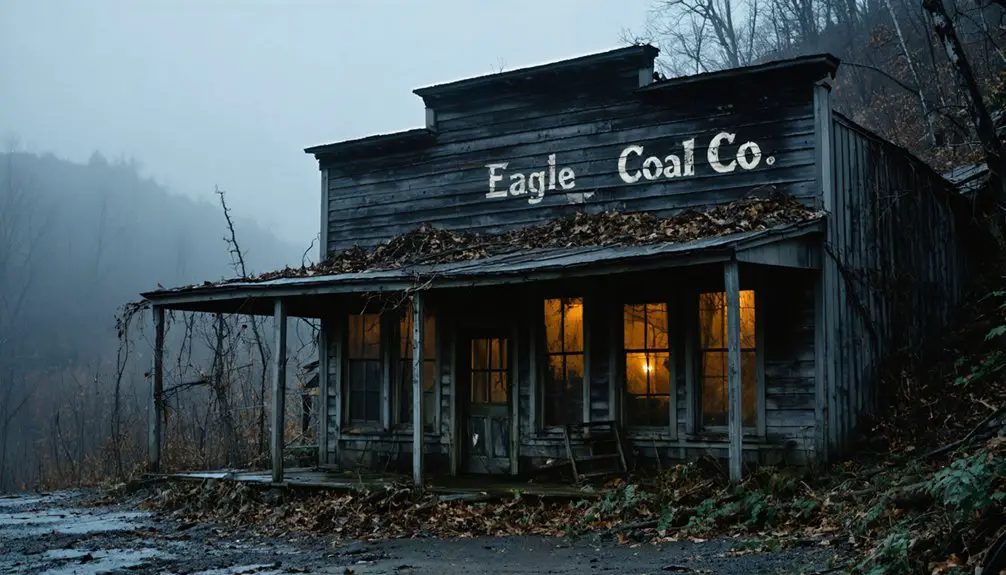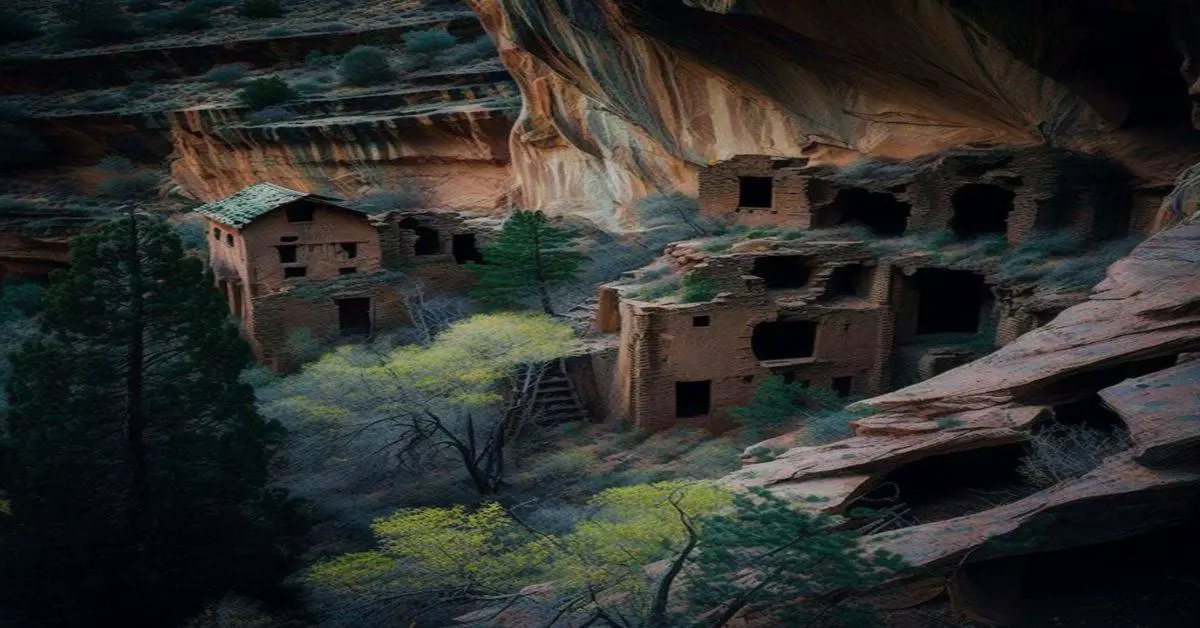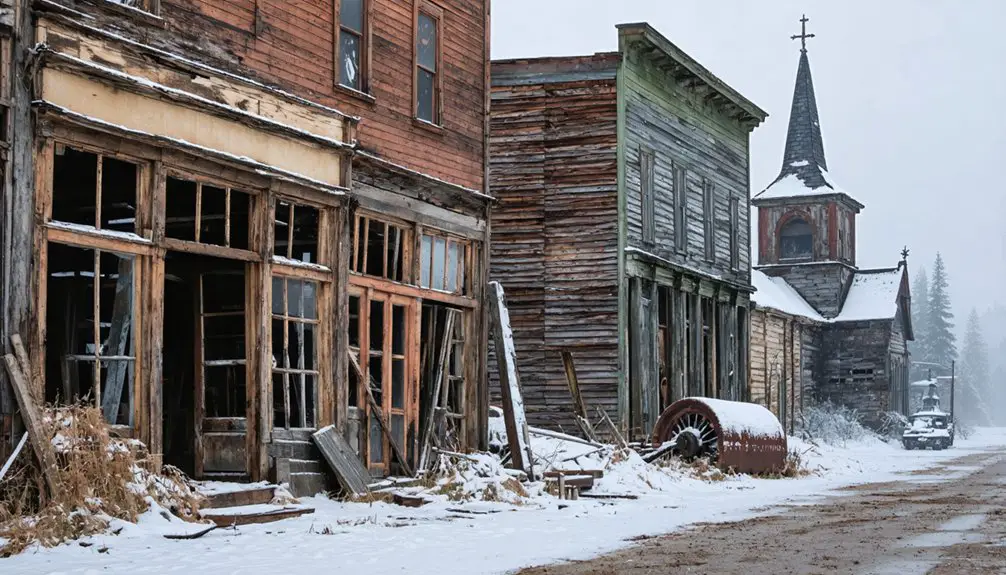You’ll find Eagle nestled in West Virginia’s Coal River Valley, a ghost town that emerged in 1883 with the railroad’s arrival. During its heyday, this bustling mining settlement centered around the Eagle underground mine near Shumate’s Branch, extracting valuable bituminous coal. The town earned the nickname “Dodge City East” for its lawless reputation, complete with high-stakes poker games at the Dunglen Hotel. After the mines closed and railroad service ended, Eagle’s story shifted from boom to abandonment, though its crumbling structures still whisper tales of Appalachian coal culture.
Key Takeaways
- Eagle, West Virginia was established in 1883 as a coal mining town centered around the Eagle underground mine near Shumate’s Branch.
- The town’s decline began when mining jobs disappeared due to resource depletion, causing families to abandon homes in search of work.
- Known as “Dodge City East,” Eagle featured the Dunglen Hotel and Ballyhack district, famous for high-stakes gambling and nightlife.
- The B&O Railroad abandonment in the 1970s and flood damage severely isolated the community, accelerating its transformation into a ghost town.
- Environmental damage from the Black Eagle Deep Mine left lasting impacts, including contaminated water sources and destroyed landscapes.
The Rise of a Coal Mining Settlement
As railroads pushed into southern West Virginia’s Coal River Valley in 1883, Eagle emerged as an essential coal mining settlement centered around its namesake underground mine near Shumate’s Branch.
You’ll find that Eagle’s story mirrors the determined spirit of countless Appalachian mining towns, where coal mining techniques evolved from basic shaft mining to sophisticated continuous mining methods.
The town grew rapidly as workers tapped into the rich Coalburg and Eagle seams, extracting valuable bituminous coal for both metallurgical and thermal markets. Today, Newtown Energy Inc. continues this legacy as the mine’s primary operator.
Community resilience took shape as mining families built their lives around the Eagle Mine’s operations, transforming what was once wilderness into a bustling coal town, though many residents like the Walk family have witnessed the harsh reality of black lung disease from generations of mining work.
The mine’s strategic location allowed for efficient transport via CSX rail lines and river barges, cementing Eagle’s role in America’s industrial growth.
Daily Life in Eagle’s Prime Years
In Eagle’s prime, you’d find mining families waking before dawn, with fathers and older sons heading to the coal mines while mothers prepared meals and maintained their company-owned homes.
Your social life would center around the company-built gathering halls, where families hosted community suppers, holiday celebrations, and church functions that helped forge strong bonds among residents.
You’d notice the tight-knit atmosphere that developed as neighbors supported each other through mining accidents, economic hardships, and the shared experience of living in this isolated West Virginia coal town. The local National Bank of Thurman was a daily meeting point for residents handling their finances and catching up on community news. Most residents relied on the company store for all their household needs, from food to clothing to mining equipment.
Mining Families’ Daily Routines
Life for Eagle’s mining families revolved around the demanding schedules of coal extraction, with miners departing their company-provided homes well before daylight and returning after dark.
You’d find wives and children adapting their daily routines to support these grueling mining schedules, preparing early meals and managing household duties while fathers worked underground.
The mining routines shaped every aspect of family dynamics.
While your father labored at the coal face, earning his pay by the number of cars he’d load, you’d help your mother with chores and tend to younger siblings.
Company houses clustered near the mines made the commute easier, but the physical toll of piecework mining meant family time was largely reserved for weekends, when you’d finally get quality moments with your coal-dusted dad.
John L. Lewis’s union organizing brought significant changes to these working conditions, fighting for better hours and miners’ rights.
The transporting of coal by oxen was a common sight in the early days before the railroad electrified their operations.
Community Social Activities
While miners toiled through exhausting shifts, Eagle’s social life centered around the Dunglen Hotel, where high-stakes poker games often saw pots reaching $50,000.
You’d find the heart of the nightlife culture in “Ballyhack” district, where saloons served whiskey by the quart and gambling tables never stayed empty. The mix of miners, railroad crews, and transient workers created a vibrant scene where community gatherings often merged business with pleasure – coal deals were sometimes sealed over poker hands. The town gained notoriety as the “Dodge City East” due to its lawless reputation. Just like in Thurmond, the town experienced significant health problems as residents dealt with constant noise from steam engines and widespread tuberculosis.
Despite early attempts to establish an orderly town prohibiting liquor and gambling, Eagle embraced an “anything goes” atmosphere.
When you weren’t working, you’d likely find yourself among the close-knit neighborhood interactions in worker housing areas or joining the lively weekend crowds at local establishments.
Economic Forces Behind the Exodus
If you’d lived in Eagle during its decline, you’d have witnessed the overnight disappearance of mining jobs when resource depletion forced operations to close.
You’d have already felt trapped by the coal company’s restrictive scrip payment system, which limited your purchasing power to company-owned stores and created a cycle of dependency.
When the mines shut down, Eagle’s crucial railroad connections were severed, isolating the town and making it nearly impossible for remaining residents to access outside economic opportunities. Like coal camp Vanlier, which once housed over 4,000 residents before its decline, Eagle experienced a dramatic population exodus. The community experienced a similar fate to other mining towns like Eagle Mountain, California, which saw its population drop drastically by 1980.
Mining Jobs Vanish Overnight
As coal deposits depleted beneath West Virginia’s rugged terrain, Eagle’s mining operations ground to an abrupt halt, triggering a devastating chain reaction throughout the community.
The sudden job displacement left miners with few options, exposing the economic fragility of company towns built entirely around coal extraction.
You’ll understand the brutal swiftness of Eagle’s decline through these key events:
- Mine operators ceased production immediately when coal reserves ran out, leaving workers without notice or severance.
- Company stores, which had monopolized local commerce through scrip payment systems, shuttered their doors.
- Families were forced to abandon company-owned homes, sparking a mass exodus as they searched for work in distant coal fields.
Without alternative industries or skilled trade opportunities, Eagle’s workforce scattered, leaving behind empty streets and crumbling infrastructure.
Coal Company Scrip Control
Before Eagle’s mining operations ceased, the coal company’s iron grip on the local economy manifested through its scrip system – a private currency that chained miners to company-owned stores and services.
You’d find these metal tokens, often bearing distinctive shapes or cutouts, serving as your only means of purchasing life’s necessities. The company’s scrip dominance meant you couldn’t shop anywhere else, forcing you to pay inflated prices at the company store.
If you needed cash before payday, you’d “draw scrip” – but this apparent convenience created crushing economic dependency. When you tried exchanging scrip for real dollars, you’d lose value on every transaction.
This calculated system trapped your family in a cycle of debt, ensuring you remained tethered to Eagle’s coal camp, powerless against the company’s control.
Transportation Networks Collapse
The decline of Eagle’s transportation networks struck another devastating blow to the community already struggling under the coal company’s economic control.
You’d witness the critical collapse of rail service by the late 1920s, followed by the devastating 1985 flood that crippled remaining transportation infrastructure. The town’s isolation deepened as:
- Passenger trains stopped running in 1928, cutting off essential mobility for residents seeking economic opportunities elsewhere.
- The B&O Railroad’s abandonment in the 1970s left the region dependent on unreliable freight-only service.
- Growing competition from highways diverted both passengers and cargo, while flood damage to bridges and tracks went unrepaired.
This transportation breakdown sealed Eagle’s fate, as you couldn’t sustain commerce or community without reliable ways to move people and goods.
Architectural Legacy and Remaining Structures

While Eagle’s architectural heritage mirrors other West Virginia coal towns like Edgerton and Thurmond, its rapidly constructed infrastructure served the essential needs of a bustling mining community.
You’ll find architectural styles that emphasized practicality, featuring modest wooden frame houses and durable stone block buildings with terracotta insulation. The historical significance of Eagle’s structures reveals itself through remaining elements like the depot, gabled houses, and industrial remnants.
Today, you can spot the blend of decayed wood, stone masonry, and early concrete techniques throughout the ghost town.
Empty lots mark where hotels and engine houses once stood, while boarded-up residences and crumbling utility buildings tell the story of Eagle’s decline. Some structures have been adapted for new uses, though many remain as silent testimonies to the coal mining era.
Environmental Impact and Natural Reclamation
Decades after coal mining operations ceased, Eagle’s environmental legacy persists through widespread ecological disruption and contamination.
You’ll find extensive environmental degradation from the Black Eagle Deep Mine, where coal dust still plagues nearby communities and toxic waste continues to threaten local watersheds.
The mine’s devastating impact includes:
- Persistent air pollution and black residue that infiltrates homes
- Destroyed forests and mountain landscapes that resist natural recovery
- Contaminated water sources affected by acid mine drainage and heavy metals
Despite various reclamation strategies, the harsh chemical conditions make it difficult for vegetation to return naturally.
You’re witnessing a landscape where mining’s footprint remains visible through scarred terrain, compromised soil quality, and disrupted natural drainage patterns that continue to challenge restoration efforts.
Personal Stories From Former Residents
Down in Eagle’s coal-dusted streets, you’ll find stories of resilience woven through the memories of former residents who once called this company town home.
Their personal reflections paint a picture of tight-knit community bonds forged in the shadow of the mines, where families shared both hardships and triumphs. You’ll hear tales of life centered around the company store, where workers spent their scrip, and of children playing near modest homes while their fathers worked underground.
When the mines closed, these residents witnessed their town’s gradual decline.
Yet their stories don’t end in defeat – they speak of maintaining connections to their heritage, returning to tend family cemeteries, and preserving their coal camp culture through generations of storytelling, even as Eagle transformed into a ghost town.
Historical Significance in West Virginia’s Mining Era
During West Virginia’s booming coal era, Eagle emerged as a quintessential company town that embodied the rapid industrialization of Appalachia’s mineral-rich mountains.
You’ll find that Eagle’s story perfectly captures the economic dependency that defined these mining communities, where coal companies controlled every aspect of daily life.
The town’s historical significance can be measured in three key ways:
- It demonstrated how coal mining companies could rapidly transform wilderness into industrial settlements.
- It exemplified the scrip-based economy that kept miners financially tethered to their employers.
- It represented the broader pattern of boom-and-bust cycles that shaped Appalachian communities.
Eagle’s legacy continues to remind you of the complex relationship between industrial progress and personal liberty in West Virginia’s mining history, serving as a powerful reflection of the era’s social and economic dynamics.
Preserving Eagle’s Memory for Future Generations
While Eagle’s physical structures continue to deteriorate, dedicated preservation efforts have emerged to safeguard its historical legacy.
Though time takes its toll on Eagle’s buildings, passionate preservationists work tirelessly to protect the town’s treasured history.
You’ll find passionate local historians collecting oral history interviews from former residents and their descendants, building extensive community archives that capture everyday life in this once-thriving mining town.
The preservation work extends beyond documentation.
You can witness ongoing stabilization efforts that protect remaining structures through careful repairs, drainage improvements, and vegetation control.
When you visit Eagle today, you’ll notice interpretive signage and guided tours that bring its mining heritage to life.
Through school programs, digital resources, and annual commemorative events, Eagle’s story reaches new generations, ensuring that this important chapter in West Virginia’s industrial past won’t be forgotten.
Frequently Asked Questions
Are There Any Documented Paranormal Activities or Ghost Sightings in Eagle?
You won’t find any verified ghostly encounters or haunting legends here – research shows no documented paranormal activities or ghost sightings, unlike other West Virginia ghost towns with established supernatural histories.
What Happened to the Town’s Official Records and Documents?
Millions of critical records vanished when mining companies abandoned operations. You won’t find many official documents today – they’re mostly lost archives, scattered between state offices or destroyed before any historical preservation efforts began.
Can Visitors Legally Explore Eagle’s Remains Today?
You’ll need explicit permission for legal access since most structures are privately owned. Follow exploration guidelines carefully – respect property boundaries, watch for hazards, and obtain landowner approval before entering.
Were There Any Major Disasters or Accidents in Eagle’s Mining Operations?
Mournful mining accidents marked Eagle’s history, with the devastating 2010 Upper Big Branch Montcoal Eagle Mine explosion being the deadliest, killing 29 miners through a catastrophic methane blast in Raleigh County.
Did Eagle Have Any Connection to the Mine Wars Movement?
You won’t find clear evidence linking Eagle’s history directly to the Mine Wars movement. While labor disputes swept through West Virginia’s coalfields, historical records don’t specifically mention Eagle’s involvement.
References
- https://www.onlyinyourstate.com/experiences/california/vacant-ghost-town-socal
- https://www.youtube.com/watch?v=-EeLwLa2t90
- https://kids.kiddle.co/List_of_ghost_towns_in_West_Virginia
- https://wonderfulwv.com/a-glimpse-into-history/
- https://en.wikipedia.org/wiki/List_of_ghost_towns_in_West_Virginia
- https://www.gem.wiki/Kanawha_Eagle_Mine
- https://minesafety.wv.gov/historical-statistical-data/mining-in-west-virginia-a-capsule-history/
- https://grist.org/protest/what-happened-to-the-war-on-coal-in-west-virginia/
- https://kids.kiddle.co/Eagle
- https://www.loc.gov/item/cmns000127/



